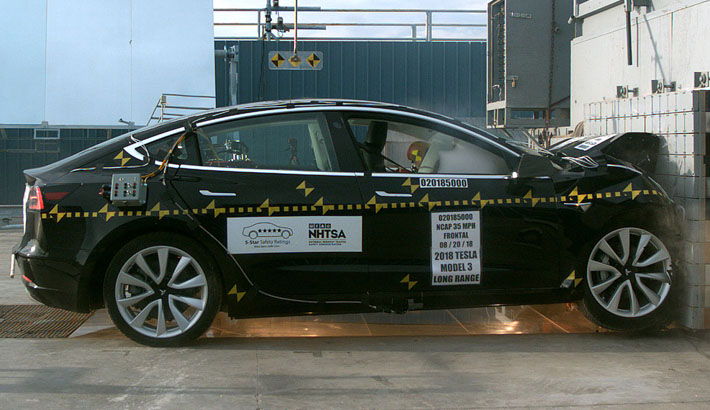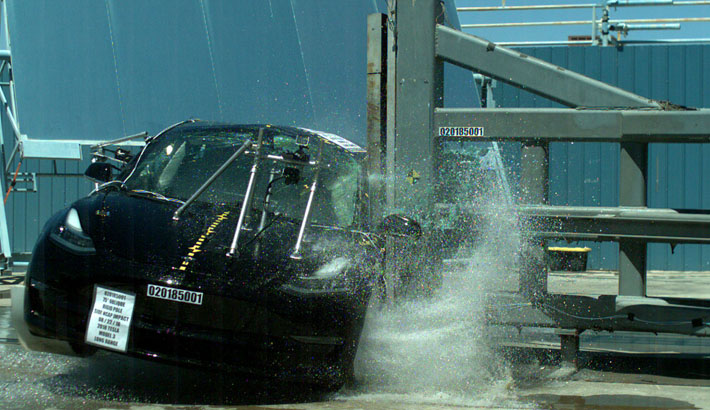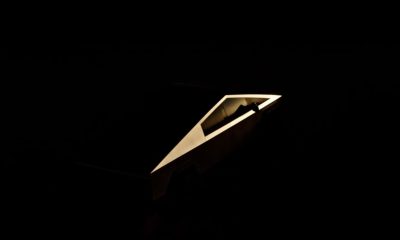

News
Tesla Model 3 named as vehicle with ‘lowest probability of injury’ by the NHTSA
The National Highway Traffic Safety Administration (NHTSA) has dubbed the Long Range RWD Tesla Model 3 as the vehicle with the lowest probability of injury among all cars that the agency has tested so far. The Model 3’s low likelihood of injury rating was given after the vehicle went through the NHTSA’s New Car Assessment Program, which involves a series of crash tests determining the likelihood of serious passenger injury for front, side, and rollover crashes.
The Model 3’s stellar rating from the NHTSA could be seen as yet another testament to the quality of Tesla’s all-electric cars. Immediately following the Model 3’s scores, after all, are the Model S and Model X, which are currently the vehicles considered by the NHTSA with the second and third lowest probabilities of injury. In a blog post announcing the electric sedan’s safety ratings, Tesla noted that it expects the Dual Motor AWD Model 3 to perform just as well in the NHTSA’s tests as its Long Range RWD sibling.
Part of the reason why the Model 3 is so safe is due to the vehicle’s all-electric design. Tesla opted to place the Model 3’s battery pack, the heaviest component of the vehicle, right at the car’s center of gravity. This gives the Model 3 performance and handling that is almost similar to that of mid-engine vehicles, while allowing the electric sedan to have a near 50/50 weight distribution. Other subtle design tweaks, such as the rear motor being placed slightly in front of the axle, further improve the Model 3’s weight distribution, as well as its overall agility and handling.
Model 3 provides superior safety with its front crumple zone which is optimized to absorb energy and crush upon impact https://t.co/RJEn0LlVNi pic.twitter.com/foF7CXPCc0
— Tesla (@Tesla) October 8, 2018
In true Tesla tradition, the Model 3’s all-electric architecture comprises of a sturdy, rigid passenger compartment, a fortified battery pack, and a low center of gravity. Just like its larger siblings, the Model S and X, the absence of an internal combustion engine in front and a fuel tank at the rear give the Model 3 extra large crumple zones, which are optimized to absorb energy and crush more efficiently in the event of an accident.
In the event of a frontal crash, the crumple zone at the front of the vehicle controls the deceleration of occupants, while the Model 3’s advanced restraint systems keep occupants safe in place. Passenger airbags are even specially designed to protect an occupant’s head in the event of an angled or offset crash, while active vents enable the vehicle to adjust the internal pressure of the frontal airbags when deploying. These systems optimize protection based on the specifics of an accident.
The Model 3’s energy-absorbing lateral and diagonal beam structures help occupants safe during pole impact crashes. These structures include a high-strength aluminum bumper beam, a sway bar placed close and forward in front of the car, cross members are the front of the steel subframe that are connected to the main crash fails, as well as diagonal beams in the subframe that distribute energy back to the crash rails when they are not directly impacted. An ultra-high-strength martensitic steel beam is further fitted on the front of the suspension to absorb crash energy from severe impacts.

Tesla also designed the Model 3 with a patented pillar structure and side sills to absorb as much energy as possible in a short distance. Coupled with the vehicle’s rigid body construction and fortified battery architecture, these design elements enable the Model 3 to reduce and prevent compartment intrusion in the event of an accident, while allowing its side airbags to have more space to inflate and cushion occupants.
Just like the Model S and Model X, the Model 3’s low center of gravity plays a key role in keeping the vehicle safe from rollover crashes. That said, even if a rollover does occur, Tesla notes that internal tests have shown that the Model 3 is capable of withstanding roof-crush loads equivalent to more than four times the electric sedan’s weight, far more than the NHTSA’s standards that require cars to withstand three times their own weight.
.@NHTSAgov will post final safety probability stats soon. Model 3 has a shot at being safest car ever tested.
— Elon Musk (@elonmusk) September 20, 2018
The Model 3 was recently given a flawless 5-Star Safety Rating in all categories and subcategories by the NHTSA. In a follow-up tweet to the NHTSA’s Model 3 results, Elon Musk noted on Twitter that the electric sedan has a shot at being the “safest car ever tested” by the agency. With the Model 3 being dubbed as the vehicle with the lowest probability of injury by the NHTSA, it appears that Musk’s statement has proven to be accurate.
Model 3 has the lowest intrusion from side pole impact of any vehicle tested by @NHTSAgov https://t.co/RJEn0LlVNi pic.twitter.com/ZvGCC82rEX
— Tesla (@Tesla) October 8, 2018
It’s not just the NHTSA that has given the Model 3 its approval, either. Earlier this year, the Insurance Institute for Highway Safety (IIHS), a nonprofit funded by auto insurers aimed at reducing accidents on the road, gave the Model 3 a “Superior” front crash avoidance rating. During the course of its testing, the Model 3 performed well in the crash avoidance and mitigation category, thanks to the vehicle’s Forward Collision Warning, its low-speed autobrake, and its high-speed autobrake systems. The Model 3 was also given a “Recommended” rating by Consumer Reports, after an over-the-air software update reduced the vehicle’s braking distance.
Tesla’s electric cars are known for their performance and their safety. The Model X, for one, also received 5-Star Safety Ratings in all categories and subcategories during the NHTSA’s tests. The Model S, on the other hand, performed so well during the NHTSA’s safety evaluation that the agency’s crash-testing gear broke while it was testing the electric sedan.
Elon Musk
Tesla begins expanding Robotaxi access: here’s how you can ride
You can ride in a Tesla Robotaxi by heading to its website and filling out the interest form. The company is hand-picking some of those who have done this to gain access to the fleet.

Tesla has begun expanding Robotaxi access beyond the initial small group it offered rides to in late June, as it launched the driverless platform in Austin, Texas.
The small group of people enjoying the Robotaxi ride-hailing service is now growing, as several Austin-area residents are receiving invitations to test out the platform for themselves.
The first rides took place on June 22, and despite a very small number of very manageable and expected hiccups, Tesla Robotaxi was widely successful with its launch.
Tesla Robotaxi riders tout ‘smooth’ experience in first reviews of driverless service launch
However, Tesla is expanding the availability of the ride-hailing service to those living in Austin and its surrounding areas, hoping to gather more data and provide access to those who will utilize it on a daily basis.
Many of the people Tesla initially invited, including us, are not local to the Austin area.
There are a handful of people who are, but Tesla was evidently looking for more stable data collection, as many of those early invitees headed back to where they live.
The first handful of invitations in the second round of the Robotaxi platform’s Early Access Program are heading out to Austin locals:
I just got a @robotaxi invite! Super excited to go try the service out! pic.twitter.com/n9mN35KKFU
— Ethan McKanna (@ethanmckanna) July 1, 2025
Tesla likely saw an influx of data during the first week, as many traveled far and wide to say they were among the first to test the Robotaxi platform.
Now that the first week and a half of testing is over, Tesla is expanding invites to others. Many of those who have been chosen to gain access to the Robotaxi app and the ride-hailing service state that they simply filled out the interest form on the Robotaxi page of Tesla’s website.
That’s the easiest way you will also gain access, so be sure to fill out that form if you have any interest in riding in Robotaxi.
Tesla will continue to utilize data accumulated from these rides to enable more progress, and eventually, it will lead to even more people being able to hail rides from the driverless platform.
With more success, Tesla will start to phase out some of the Safety Monitors and Supervisors it is using to ensure things run smoothly. CEO Elon Musk said Tesla could start increasing the number of Robotaxis to monitors within the next couple of months.
Elon Musk
Tesla analyst issues stern warning to investors: forget Trump-Musk feud

A Tesla analyst today said that investors should not lose sight of what is truly important in the grand scheme of being a shareholder, and that any near-term drama between CEO Elon Musk and U.S. President Donald Trump should not outshine the progress made by the company.
Gene Munster of Deepwater Management said that Tesla’s progress in autonomy is a much larger influence and a significantly bigger part of the company’s story than any disagreement between political policies.
Munster appeared on CNBC‘s “Closing Bell” yesterday to reiterate this point:
“One thing that is critical for Tesla investors to remember is that what’s going on with the business, with autonomy, the progress that they’re making, albeit early, is much bigger than any feud that is going to happen week-to-week between the President and Elon. So, I understand the reaction, but ultimately, I think that cooler heads will prevail. If they don’t, autonomy is still coming, one way or the other.”
BREAKING: GENE MUNSTER SAYS — $TSLA AUTONOMY IS “MUCH BIGGER” THAN ANY FEUD 👀
He says robotaxis are coming regardless ! pic.twitter.com/ytpPcwUTFy
— TheSonOfWalkley (@TheSonOfWalkley) July 2, 2025
This is a point that other analysts like Dan Ives of Wedbush and Cathie Wood of ARK Invest also made yesterday.
On two occasions over the past month, Musk and President Trump have gotten involved in a very public disagreement over the “Big Beautiful Bill,” which officially passed through the Senate yesterday and is making its way to the House of Representatives.
Musk is upset with the spending in the bill, while President Trump continues to reiterate that the Tesla CEO is only frustrated with the removal of an “EV mandate,” which does not exist federally, nor is it something Musk has expressed any frustration with.
In fact, Musk has pushed back against keeping federal subsidies for EVs, as long as gas and oil subsidies are also removed.
Nevertheless, Ives and Wood both said yesterday that they believe the political hardship between Musk and President Trump will pass because both realize the world is a better place with them on the same team.
Munster’s perspective is that, even though Musk’s feud with President Trump could apply near-term pressure to the stock, the company’s progress in autonomy is an indication that, in the long term, Tesla is set up to succeed.
Tesla launched its Robotaxi platform in Austin on June 22 and is expanding access to more members of the public. Austin residents are now reporting that they have been invited to join the program.
Elon Musk
Tesla surges following better-than-expected delivery report
Tesla saw some positive momentum during trading hours as it reported its deliveries for Q2.

Tesla (NASDAQ: TSLA) surged over four percent on Wednesday morning after the company reported better-than-expected deliveries. It was nearly right on consensus estimations, as Wall Street predicted the company would deliver 385,000 cars in Q2.
Tesla reported that it delivered 384,122 vehicles in Q2. Many, including those inside the Tesla community, were anticipating deliveries in the 340,000 to 360,000 range, while Wall Street seemed to get it just right.
Tesla delivers 384,000 vehicles in Q2 2025, deploys 9.6 GWh in energy storage
Despite Tesla meeting consensus estimations, there were real concerns about what the company would report for Q2.
There were reportedly brief pauses in production at Gigafactory Texas during the quarter and the ramp of the new Model Y configuration across the globe were expected to provide headwinds for the EV maker during the quarter.
At noon on the East Coast, Tesla shares were up about 4.5 percent.
It is expected that Tesla will likely equal the number of deliveries it completed in both of the past two years.
It has hovered at the 1.8 million mark since 2023, and it seems it is right on pace to match that once again. Early last year, Tesla said that annual growth would be “notably lower” than expected due to its development of a new vehicle platform, which will enable more affordable models to be offered to the public.
These cars are expected to be unveiled at some point this year, as Tesla said they were “on track” to be produced in the first half of the year. Tesla has yet to unveil these vehicle designs to the public.
Dan Ives of Wedbush said in a note to investors this morning that the company’s rebound in China in June reflects good things to come, especially given the Model Y and its ramp across the world.
He also said that Musk’s commitment to the company and return from politics played a major role in the company’s performance in Q2:
“If Musk continues to lead and remain in the driver’s seat, we believe Tesla is on a path to an accelerated growth path over the coming years with deliveries expected to ramp in the back-half of 2025 following the Model Y refresh cycle.”
Ives maintained his $500 price target and the ‘Outperform’ rating he held on the stock:
“Tesla’s future is in many ways the brightest it’s ever been in our view given autonomous, FSD, robotics, and many other technology innovations now on the horizon with 90% of the valuation being driven by autonomous and robotics over the coming years but Musk needs to focus on driving Tesla and not putting his political views first. We maintain our OUTPERFORM and $500 PT.”
Moving forward, investors will look to see some gradual growth over the next few quarters. At worst, Tesla should look to match 2023 and 2024 full-year delivery figures, which could be beaten if the automaker can offer those affordable models by the end of the year.
-

 Elon Musk2 days ago
Elon Musk2 days agoTesla investors will be shocked by Jim Cramer’s latest assessment
-

 News1 week ago
News1 week agoTesla Robotaxi’s biggest challenge seems to be this one thing
-

 Elon Musk2 weeks ago
Elon Musk2 weeks agoElon Musk slams Bloomberg’s shocking xAI cash burn claims
-

 News2 weeks ago
News2 weeks agoTexas lawmakers urge Tesla to delay Austin robotaxi launch to September
-

 Elon Musk1 week ago
Elon Musk1 week agoFirst Look at Tesla’s Robotaxi App: features, design, and more
-

 Elon Musk2 weeks ago
Elon Musk2 weeks agoTesla Robotaxis are becoming a common sight on Austin’s public roads
-

 Elon Musk2 weeks ago
Elon Musk2 weeks agoxAI’s Grok 3 partners with Oracle Cloud for corporate AI innovation
-

 Elon Musk2 weeks ago
Elon Musk2 weeks agoSpaceX President meets India Minister after Starlink approval















